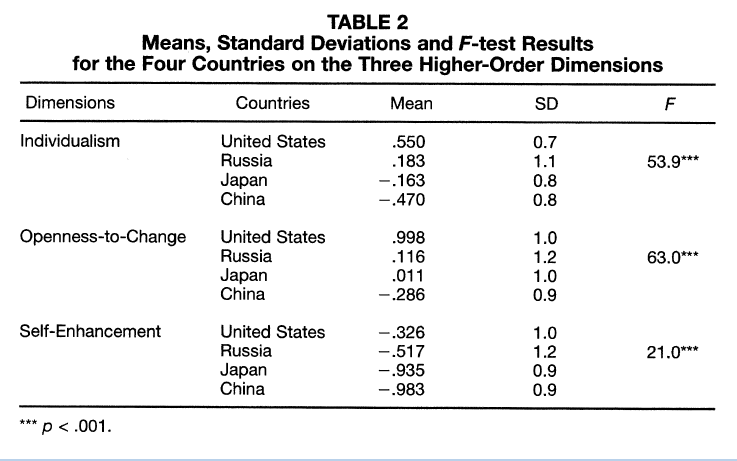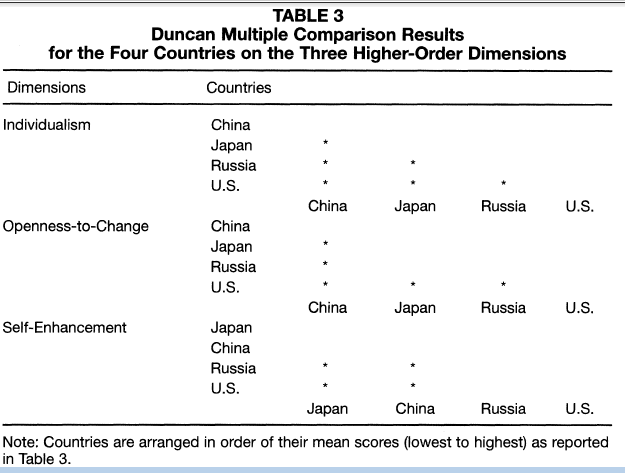
Measure
The Schwartz Value Survey (SVS) was selected as our measure. The SVS consists of fiftysix items. Each of the fifty-six items is measured with a nine-point Likert scale that ranged from opposed to my values [-1 ] through important [3] to of supreme importance [7]. The ten universal subdimensions of motivation are found in every culture; however, the level of importance of each varies from one culture to the next [Schwartz and Bilsky 1990]. The subdimensions may range from a value of 7 to a value of - 1. These subdimensions are clustered to create the higher-order dimensional continua.

SVS Higher-Order Dimensional Continua. The higher-order dimensions were developed from data collected in twenty countries [Schwartz 1992]. Initially, Schwartz drew a contrast between individualistic and collectivistic orientations
The subdimensionst hat make up Individualism are: Power, Achievement, Hedonism,S timulation, and Self-Direction.C ollectivisma, t the othere nd of the continuum,i s comprisedo f the Benevolence, Tradition and Conformity subdimensions.
Schwartz [1992] also identifies two higher-order motivational continua, Openness-to-Change-Conservatiaond Self-Enhancement-Self-Transcendenceth, at more precisely describe the Individualism-Collectivism differences. The Openness-to-Change-Conservatiocno ntinuum contrasts the extent to which individuals are motivated to follow their own intellectual and emotional interests versus the extent to which they are motivated to preserve the status quo
Openness-to-Change,
which is comprised of the Stimulation and Self-Direction subdimensions, represents the Individualism nd of the continuum. ConverselyC, onservationis comprised of Security Conformity and Tradition
Procedure and Design
Subjects were given a native language version of the SVS instrument. They were informed that there were no right or wrong answers, and that it was only their opinions that mattered. They also were told that their anonymity would be maintained.
Analysis
The first step of the analysis was to calculate a one-way MANOVA where the three higher-order dimensional continua - Individualism, Openness-Change and Self-Enhancement are dependent variables. The MANOVA had four levels-one for each of the four countries. The analysis of the subdimensions followed a similar procedure to that described for the higher-order dimensional continua.
The subdimension information is presented in tabular form and discussed to help clarify the hypothesized relationships among the four countries. The approach of this analysis is consistent with the one used in the Ralston et al.
RESULTS
Higher-Order Dimensions
The MANOVA indicated a significant Wilks' lambda effect [A=.723, df=3,5,855, p<.001]. Since this effect was significant, univariate ANOVAs were calculated to determine the significance of each of the three higher-order dimensional continua- Individualism Openness-to-Change and Self-Enhancement. All three ANOVAs were significant. The means, standard deviations, and F-test results of these ANOVAs are reported in Table 2. Since all ANOVAs were significant multiplec omparison tests were run for the three higher-order dimensional continua. These Duncan results are reported in Table 3. Cronbach'sa lphaw as calculated by country for each of the six dimensions that create the three dimensional continua. All twenty-four alphas exceeded the .66 level.


Individualism-Collectivism --the mean scores of managers from the U.S. were significantly higher than those from the other three countries. Likewise, the scores of Russian managers were significantly higher than those of the Japanese or Chinese managers, and Japanese managers scored significantly higher than their Chinese counterparts.
Openness-to-Change-Conservation - the U.S. managers scoring significantly higher than the managers from the other three countries, and the Russian and Japanese managers scoring significantly higher than the Chinese managers.
Self-Enhancement-Self-Transcendence.- shows how the U.S. and Russian managers grouping and the Japanese and Chinese managers also grouping, with the U.S.-Russian grouping being significantly higher on Self-Enhancement than the Japanese-Chinese grouping.
